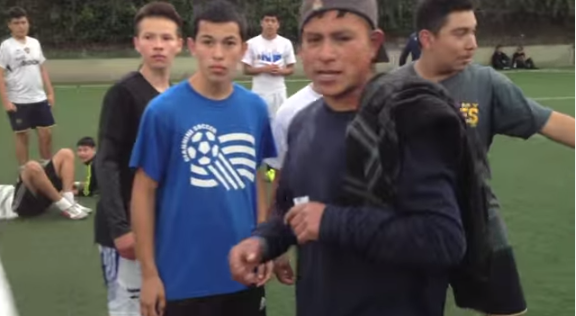Here’s what happens. The Mission soccer field in San Francisco is run by a long tradition of pick-up soccer, by which teams of seven play each other in turn. But recently, the San Francisco Parks and Recreation department joined forces with the private City Fields Foundation to create an app that allows reserving the field — for a fee. In the video, the neighborhood kids playing on the field confront a group that has shown up to play with a permit, and a conversation ensues.
The Mission District has been at the epicenter of a big population migration into San Francisco. The tech boom has brought young, high-income newcomers into traditional neighborhoods, fueling the real estate market and creating a rental migration, complete with evictions of long-time residents. Other changes have included the proliferation of private corporate transportation into the South Bay, and changes in how companies offer all services on their premises, blurring the life/work divide and seeping energy from local businesses.
Both groups of soccer players — the old-timer neighborhood residents and the newcomer residents — are laying claim to the soccer field, and they are doing so from two very different perspectives about law: fairness, merit and the public good.
The old-timer pick-up system is based on communal enjoyment of the field. The teams play each other in turn, with the losing team ceding the field, until the last game is held between the two winning teams. This is a system based on tradition, on an understanding of sharing based on game quality, and on an assumption that the field, as a public good, belongs to everyone all the time. But it is also based on tradition: “This field has never been booked,” says one of the old-timer players.
The new system is based on an understanding of the court as a resource that can be shared by one group to the exclusion of others, and rather than giving the field away on the basis of quality of game, the egalitarian system of reservations through the app is supposed to even the playing field. It also encourage an optimization of the space use. But this presumed level playing field is not so level when taking into account that the use of the court is monetized, giving the “haves” an advantage over the “have nots.”
In 1960, economist Ronald Coase wrote a groundbreaking paper called The Problem of Social Cost. The paper examines a hypothetical example: A rancher and a farmer, trying to negotiate a fencing solution that would prevent the cattle from getting into the farm. Regardless of whether the county advocates “open ranch,” which requires fencing the farm, or “closed ranch,” which requires fencing the ranch, the farmer and the rancher would probably negotiate between themselves a compromise over the fencing costs. From this emerged a general principle, now known in economics as the Coase Theorem: In a world devoid of barriers preventing them from doing so, people will negotiate and reach a solution that distributes resources in the most efficient way, regardless of the way the legal regime allocates rights. (This was one of the ideas that pioneered what is now known as the law and economics movement.)
Sociologist Robert Ellickson found Coase’s ideas interesting and wanted to test them empirically, on real ranchers and farmers. He traveled to Shasta County and interviewed the residents about their patterns of negotiation and dispute resolution. Ellickson found out that the neighbors in Shasta County did, indeed, manage to bargain within themselves without involving the law; he even named his book Order Without Law.
But the Coase Theorem had limits. It only worked in the context of close-knit communities; whenever strangers were involved in a dispute, it was more difficult to reach a solution without involving law.
Indeed, unfamiliarity and different value systems pretty high barriers. And, in this case, the dispute occurs against the backdrop of a seismic change in the city’s social and economic makeup and character. For many of the old timers on the soccer field, the dispute over the two systems is merely an illustration of the hopelessness and despondency involved in seeing one’s neighborhood changing before one’s eyes. And yet, the old timers try to negotiate a solution, and they try to incorporate the newcomers into the existing informal regulatory scheme.
The newcomers, who evoke less sympathy in this video — partly because of their age, and partly because of their privilege — seem genuinely surprised to hear that the rental fee they paid electronically does not, in reality, buy them possession of the field. A charitable interpretation of their reaction might have something to do with their newness in the neighborhood; incorporating oneself into an existing social system and accepting its patterns of informal regulation and social control is not easy, certainly not when one works an hour away for many hours and spends little time in the community.
There are, of course, less charitable explanations, and the commentary on social networks usually assumed those. But San Francisco has always been in a process of change, and incorporating new people has always involved a certain amount of give-and-take. Here’s hoping that, in time, the newcomers will get to know and respect their neighbors and their ways, and that the transactional costs of interacting, bargaining and reaching an agreement will be reduced enough to allow everyone to enjoy an afternoon of soccer.









